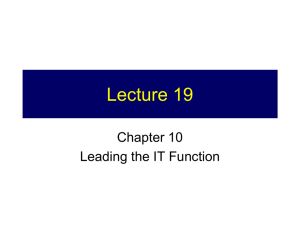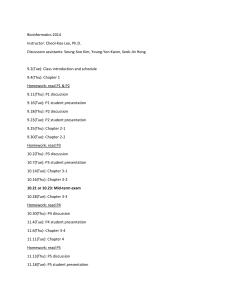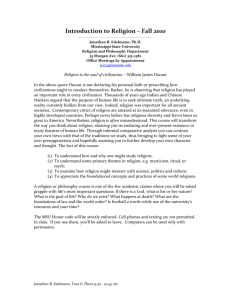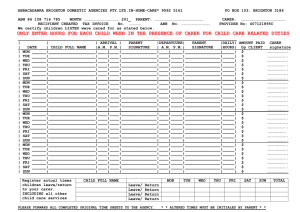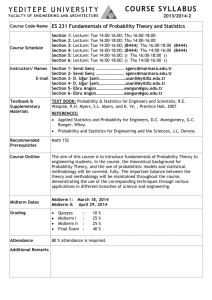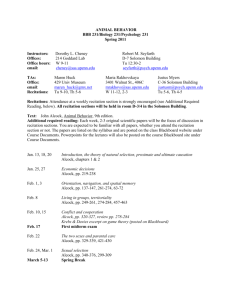W2420 Animal Behavior Spring 2012 Dr. Sarah M. N. Woolley Office
advertisement
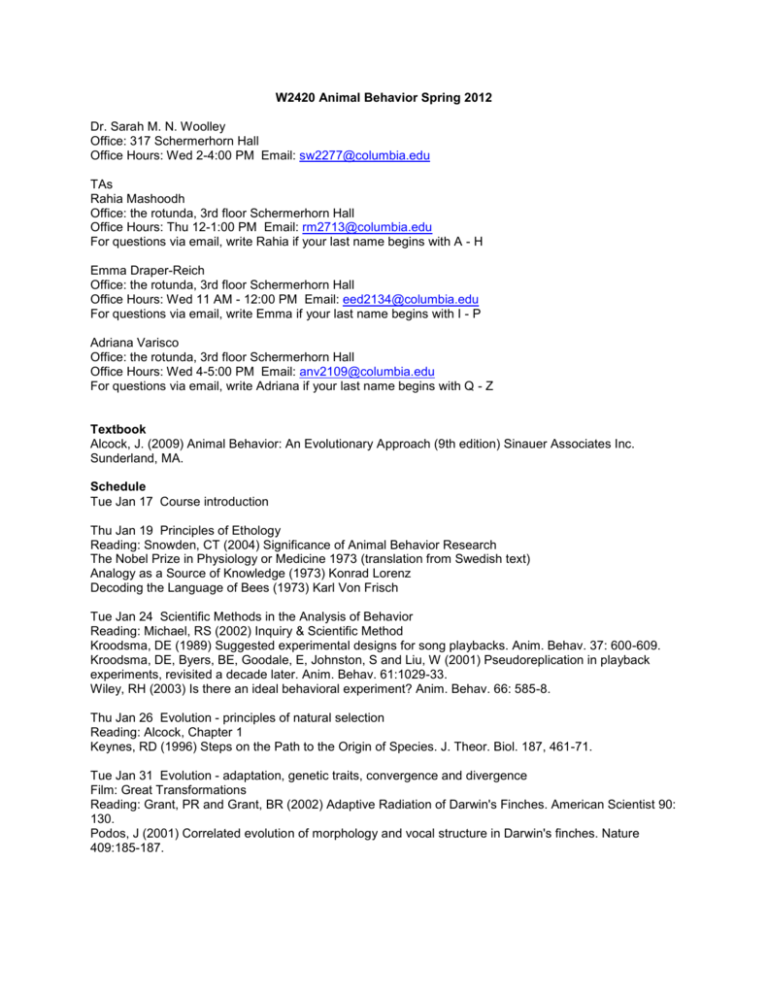
W2420 Animal Behavior Spring 2012 Dr. Sarah M. N. Woolley Office: 317 Schermerhorn Hall Office Hours: Wed 2-4:00 PM Email: sw2277@columbia.edu TAs Rahia Mashoodh Office: the rotunda, 3rd floor Schermerhorn Hall Office Hours: Thu 12-1:00 PM Email: rm2713@columbia.edu For questions via email, write Rahia if your last name begins with A - H Emma Draper-Reich Office: the rotunda, 3rd floor Schermerhorn Hall Office Hours: Wed 11 AM - 12:00 PM Email: eed2134@columbia.edu For questions via email, write Emma if your last name begins with I - P Adriana Varisco Office: the rotunda, 3rd floor Schermerhorn Hall Office Hours: Wed 4-5:00 PM Email: anv2109@columbia.edu For questions via email, write Adriana if your last name begins with Q - Z Textbook Alcock, J. (2009) Animal Behavior: An Evolutionary Approach (9th edition) Sinauer Associates Inc. Sunderland, MA. Schedule Tue Jan 17 Course introduction Thu Jan 19 Principles of Ethology Reading: Snowden, CT (2004) Significance of Animal Behavior Research The Nobel Prize in Physiology or Medicine 1973 (translation from Swedish text) Analogy as a Source of Knowledge (1973) Konrad Lorenz Decoding the Language of Bees (1973) Karl Von Frisch Tue Jan 24 Scientific Methods in the Analysis of Behavior Reading: Michael, RS (2002) Inquiry & Scientific Method Kroodsma, DE (1989) Suggested experimental designs for song playbacks. Anim. Behav. 37: 600-609. Kroodsma, DE, Byers, BE, Goodale, E, Johnston, S and Liu, W (2001) Pseudoreplication in playback experiments, revisited a decade later. Anim. Behav. 61:1029-33. Wiley, RH (2003) Is there an ideal behavioral experiment? Anim. Behav. 66: 585-8. Thu Jan 26 Evolution - principles of natural selection Reading: Alcock, Chapter 1 Keynes, RD (1996) Steps on the Path to the Origin of Species. J. Theor. Biol. 187, 461-71. Tue Jan 31 Evolution - adaptation, genetic traits, convergence and divergence Film: Great Transformations Reading: Grant, PR and Grant, BR (2002) Adaptive Radiation of Darwin's Finches. American Scientist 90: 130. Podos, J (2001) Correlated evolution of morphology and vocal structure in Darwin's finches. Nature 409:185-187. Thu Feb 2 Instinct and Learning Reading: Alcock, Chapter 2 Marler, P (2004) Innateness and the Instinct to Learn. An. Acad. Cienc. 76: 189-200. Tue Feb 7 Development of Behavior Reading: Alcock, Chapter 3 Gardner, TJ, Naef, F and Nottebohm, F (2005) Freedom and rules: the acquisition and re-programming of a bird's learned song. Science 308:1046-9. Thu Feb 9 Catch Up and Review for Exam 1 Tue Feb 14 Exam 1 Thu Feb 16 Neural Control of Behavior - sensory structures, the brain, muscles, motor behavior Reading: Alcock Chapter 4 Poulet, JF and Hedwig, B (2005) Auditory orientation in crickets: pattern recognition controls reactive steering. PNAS 102: 15665-15669. Tue Feb 21 Neural Organization of Behavior Reading: Alcock Chapter 5 Sisneros, JA, Forlano, PM, Deitcher, DL and Bass AH (2004) Steroid-dependent Auditory Plasticity Leads to Adaptive Coupling of Sender and Receiver. Science 305: 404-7. Thu Feb 23 Specialized Traits for Survival - anti-predator behavior Reading: Alcock, Chapter 6 Film: The Evolutionary Arms Race Tue Feb 28 Specialized Traits for Survival - arms races, parasitism Reading: Alcock, revisit Chapter 4 section on bats and moths Robert, D, Amoroso, J and Hoy, RR (1992) The evolutionary convergence of hearing in a parasitoid fly and its cricket host. Science 258: 1135-1137. Thu Mar 1 Specialized Traits for Survival - acquiring resources Reading: Alcock, Chapter 7 Raby, CR et al. (2007) Planning for the future by western scrub-jays. Nature 445:919-921. Tue Mar 6 Economics of Behavior Reading: Moller, AP (1989) Viability costs of male tail ornaments in a swallow. Nature 339: 132-5. Evans, MR (1998) Selection on swallow tail streamers. Nature 394: 233-34. Moller, AP (1999) Length of tail streamers in barn swallows. Nature 397: 115. Evans, MR (1999) Reply: Length of tail streamers in barn swallows. Nature 397: 115-116. Thu Mar 8 Ecology of Behavior Reading: Alcock, Chapter 8 Tue Mar 13 Spring Break Thu Mar 15 Spring Break Tue Mar 20 Animal Communication - signal, sender and receiver Reading: Alcock, Chapter 9 Bertram, SM, Orozco, SX and Bellani, R (2004) Temporal shifts in conspicuousness: Mate attraction displays of the Texas field cricket, Gryllus texensis. Ethology 110: 963-75. Thu Mar 22 Evolution of Communication Reading: Akre et al (2011) Signal perception in frogs and bats and the evolution of mating signals. Science 333: 751-752. Tue Mar 27 Catch Up and Review for Exam 2 Thu Mar 29 Exam 2 Tue Apr 3 Reproductive Behavior 1 Reading: Alcock, Chapters 10 & 11 Thu Apr 5 Reproductive Behavior 2 Film: Why Sex? Reading: Pilastro, A, Scagginate, M and Rasotto, MB (2002) Individual adjustment of sperm expenditure accords with sperm competition theory. PNAS, 99: 9913-5. Tue Apr 10 Parental Behavior Reading: Alcock, Chapter 12 Packer et al. (2001) Egalitarianism in Female African Lions. Science 293:690-3. Thu Apr 12 Social Behavior 1 Film: Winning Teams Reading: Alcock, Chapter 13 Tue Apr 17 Social Behavior 2 - conspecific relationships Reading: Inbal Ben-Ami Bartal et al (2011) Empathy and prosocial behavior in rats. Science 334: 143730. Thu Apr 19 Social Behavior 3 - relationships between species Reading: Bshary, R et al. (2006) Interspecific Communicative and Coordinated Hunting between Groupers and Giant Moray Eels in the Red Sea. PLoS Biol 4:2393-98. Tue Apr 24 Human Behavior Reading: Alcock, Chapter 14 Gelstein et al (2011) Human tears contain a chemosignal. Science 331: 226-30. Thu Apr 26 Catch Up and Review for Last Exam THE FINAL EXAM IS ON TUESDAY MAY 8, 9 AM TO NOON, IN SCHERMERHORN 614

